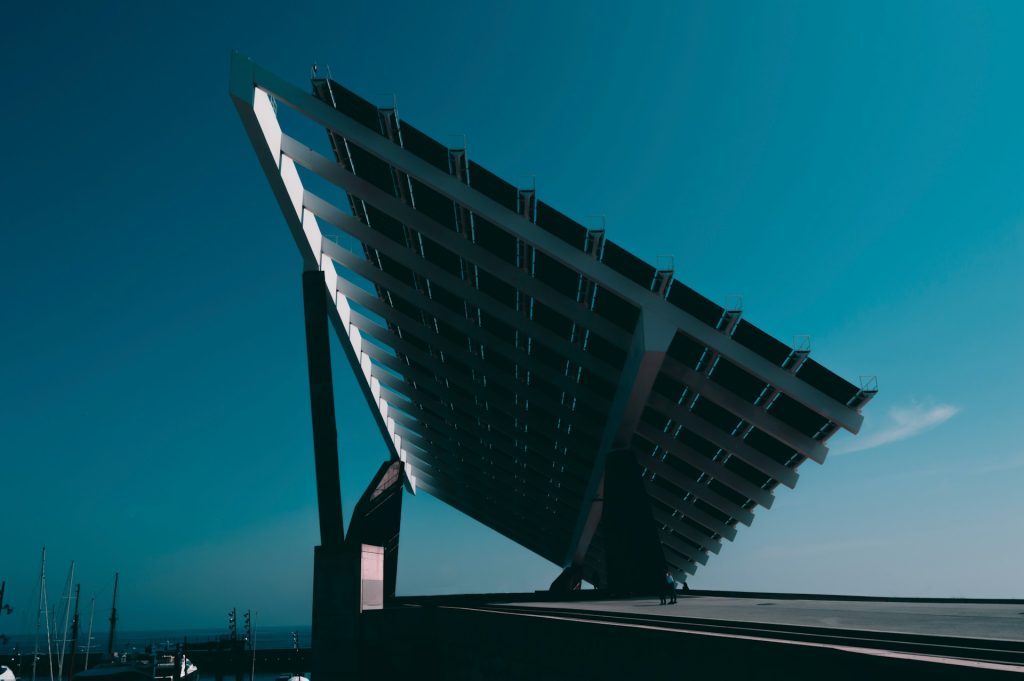Solar power has emerged as a popular, sustainable energy source for homes and businesses alike. However, many homeowners don’t realize that the type of roofing material on their property can significantly influence the selection and performance of solar panels.
Before deciding on solar energy installation, you must understand how various roofing materials impact both the placement and efficacy of solar panels. Let’s take a look at the relationship between roofing materials and solar panel choices so that homeowners can make informed decisions.

The Impact of Roof Slope
The angle or slope of a roof can greatly affect the efficiency of solar panels. Solar panels perform optimally when installed at an angle that allows them to capture maximum sunlight throughout the day. Tilting panels at an optimal angle can enhance energy absorption by up to 25%. Roof slopes ranging from 30 to 45 degrees are generally ideal for solar installations. However, flatter roofs can also support solar panels, especially with adjustable mounts that manipulate angles.
Homeowners with flat or low-slope roofs should consider additional technical solutions to ensure that their solar panels remain productive. Various options allow homeowners to overcome the limitations associated with flatter roofs and achieve effective solar energy production. When evaluating your options, professional contractors like Fowler Exteriors will ensure reliable installation tailored to your roof type. Best of all, they will have the expertise and certifications needed to get the job done right from the start.
Choosing Solar Panels for Different Roof Materials
Roofing materials vary widely, and each type presents specific challenges and opportunities for solar panel installation. Metal roofs, commonly made from steel or aluminum, tend to be some of the best options for solar panels. Their reflective surfaces minimize excess heat absorption and encourage solar energy production. On the other hand, asphalt shingles are ubiquitous in residential settings and compatible with most solar technologies.
Tile roofs, while visually appealing, may require additional consideration due to the fragility of tiles; homeowners should work with experienced installers to safely navigate potential risks. Thatched roofs are generally not suitable for solar panels due to safety hazards and structural challenges. By comprehensively assessing the impact of various roofing materials, homeowners can select the most fitting solar panels for their residences.
Thermal Expansion and Roof Durability
Thermal expansion influences the longevity and durability of both roofing materials and solar panels. Roofing materials expand and contract with temperature changes, which can create stress at attachment points and connections. Metal roofs experience significant expansion and contraction, which can potentially impact solar installations if not properly considered. The wear and tear from this movement can shorten the lifespan of both the roof and the solar panels if not addressed appropriately.
Concrete and slate tend to have lower rates of thermal expansion so that they maintain their structural integrity longer. When homeowners choose roofing materials for thermal expansion, they enhance sustainability and increase the overall efficiency of solar energy systems. Engaging with professional installers can identify potential hot spots and weakened areas on roofs that may affect solar systems.
Roof Color and Its Effects on Solar Efficiency
The color of a roofing material can have a profound impact on energy efficiency, particularly in connection with solar panel output. Light-colored roofs tend to reflect more sunlight, which reduces heat absorption. It can be incredibly beneficial in warmer climates where excessive heat can affect the overall performance of solar panels.
Conversely, darker roofing materials absorb more heat, which can lead to overheating solar panels, decreasing efficiency by as much as 20%. Various studies suggest that lighter roofs could contribute to cooler homes, thus reducing air conditioning energy consumption. Homeowners should evaluate local climate conditions and consider the trade-offs associated with roof color when planning solar installations. A deeper understanding of the interaction between roof color and solar panel effectiveness can help residents enhance their energy savings and promote sustainability.
Weight Considerations for Roofer and Panel Combinations
For older structures, the weight of both roofing materials and solar panels needs careful consideration. Some roofing materials (clay or slate tiles) are heavier than alternatives like asphalt or metal. This increase in weight may necessitate reinforcing the roof structure to support the additional load of solar panels.
Older roofs may have already deteriorated and might not withstand the extra weight, resulting in potential structural issues. Homeowners are encouraged to perform a thorough inspection of their roofs before installation to determine whether reinforcement is necessary. A professional evaluation can also uncover any hidden issues that could affect both longevity and efficiency.
Local Regulations and Permits
Each region has specific building codes and zoning laws that can influence the materials used for roofs and solar installations. In some areas, lightweight solar panel systems may be preferred to minimize any potential load on the existing structure.
Homeowners should check local ordinances to ensure their compliance before proceeding with solar installations. Know that staying informed about local policies helps in making choices that align with community standards while maximizing energy savings.

Solar panel installation is not merely a matter of choosing the most efficient panels available. The interconnection between roof materials and solar energy systems creates effective, long-lasting installations. From understanding the effects of roof slopes and colors to considering thermal factors, homeowners must examine how these aspects influence their solar choices. Now, homeowners can harness a cleaner, more sustainable source of energy.



